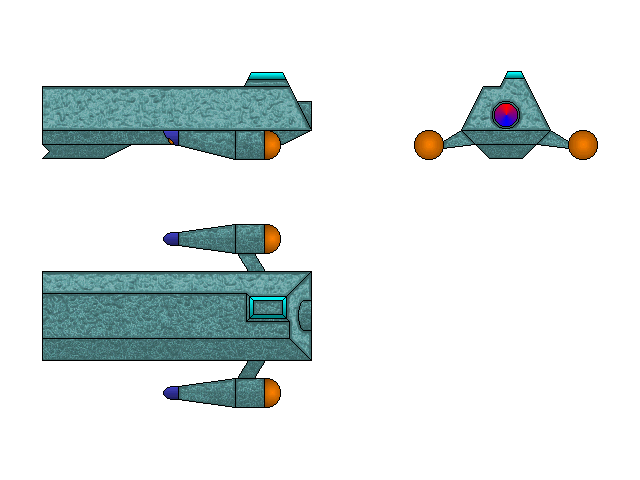
Designer: Robert C. Dunehew E-mail [email protected]

SLM-1 "Starbus" class freighter
Inscription on Commissioning plaque:
"Even if you're on the right track, you'll get run over if you just sit there."-- Will Rogers (1879-1935)
General Specifications:
Length: 27m
Width: 18.4m
Height: 8.8m
Max. Warp: 3.2
Cruise: 2.75
Max. Impulse: 0.05 lightspeed.
Crew: 3 (minimum).
Passengers: Up to 30.
Armaments: None.
Type: Standard Light Merchant, type 1.
Status: Entered production in 2089. Approximately 200 were produced. Most were scrapped and traded in for improved freighters as they reached the end of their service life. None are known to have been in use after 2174.
About Ship: The Starbus was one of Earth's first commercial freighters to enter service after the invention of warp drives. Although slow by today's standards, the Starbus was the first practical interstellar freighter produced by Earth.
The hull was constructed of welded-together monocrystalline steel plates with a protective coating of artificial sapphire ceramic for protection against micrometeorites. The bridge sat high at the front of the vessel, directly over the crew accommodations, which were in turn situated directly over the engineering section. The reaction drive was an early impulse design, mounted below the aft cargo deck. The reaction drive housing and the warp nacelles were reinforced to allow surface landings, an operation that was generally only performed in an emergency, as the SLM-1 had atrocious handling properties in atmosphere.
Most loading and offloading was performed in orbit, preferably within a space station, where the aft loading door/loading ramp and unobstructed cargo bay could be used to best advantage. The cargo deck was large and free of obstructions, capable of handling individual objects up to 4m x 4m x 20m (the length of the cargo bay by the dimensions of the loading door). Total volume of the hold was actually about a third larger than this, and the Starbus could regularly haul up to 420 cubic meters of cargo. Passenger accommodations could be installed within the cargo bay, allowing up to 30 passengers to be carried. The passenger configuration occupied 300 cubic meters of the cargo bay.
The greatest failing of the SLM-1 was its reliance on outside support to transport passengers and cargo to and from a planetary surface. The introduction of freighters with surface landing capability spelled the end of the Starbus series.
There were three further variants of the SLM-1, the main difference between the types being hull length and cargo capacity. Performance was not significantly improved until the introduction of the SLM-7 in 2210. No SLM-1 is known to have still been in service after 2174. A full-sized mock-up of a typical SLM-1 is maintained as a walk-through display at the Zephram Cochrane Memorial Space Museum in orbit at Alpha Centauri III.
Return to the Starship Catalogue.